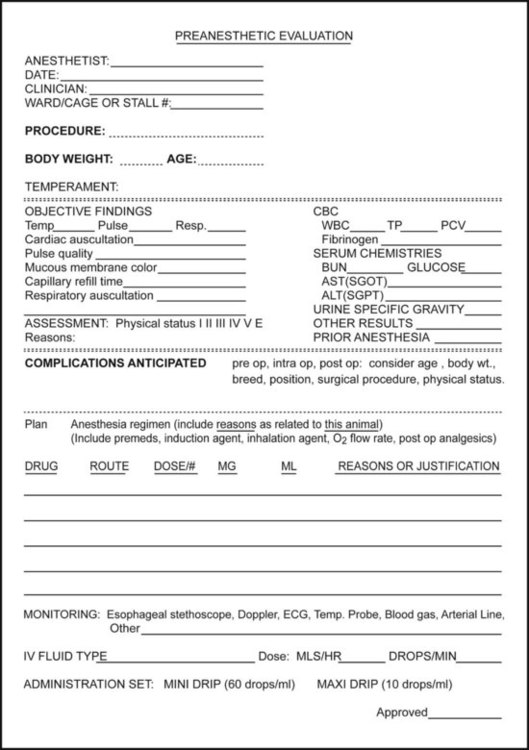I A variety of anesthetic procedures and techniques can be used to safely produce sedation, analgesia, and anesthesia in cats. Local anesthetic techniques should be considered to provide additional analgesia. II The choice of anesthetic regimen is influenced by the following characteristics: C Health and physical condition D The purpose of chemical restraint and anesthesia E Anticipated duration of anesthesia F The familiarity of personnel with the drugs being used III Drugs that can be antagonized are preferred IV Endotracheal intubation should be performed whenever possible to ensure a patent airway V Careful and attentive monitoring is mandatory to recognize and compensate for drug-related effects VI Food and water should be withheld for about 6 and 2 hours before surgery, respectively, except in very small, very young, or diseased cats I Review history and current drug therapy II Perform a physical examination III Review available laboratory data IV Formulate a specific anesthetic plan (Fig. 21-1) V Intravenous catheter placement is recommended in case of emergency VI Gather appropriate equipment and supplies A Endotracheal tube (see Chapter 11) 1. Select endotracheal tube diameter based on the size of the cat (usual range 2 to 5 mm, inner diameter [ID]; Table 21-1) TABLE 21-1 Endotracheal Tube Size for Cats 2. If using a cuffed endotracheal tube, check cuff for leaks prior to use by injecting air; deflate prior to placement 3. Use a rigid or flexible stylet for small-diameter, flimsy tubes 4. Use an uncuffed tube in very small cats (see Fig. 20-2) B Laryngoscope (see Fig. 20-3) 1. Aids intubation by allowing visualization, illumination, and manipulation of the tongue and laryngeal structures C Anesthetic machine and breathing system 1. Size and type of anesthetic system (rebreathing; nonrebreathing; see Chapter 12) determined by body weight 2. The size of the rebreathing bag should be at least 3 to 5 times the tidal volume (VT). The VT is usually between 10 and 15 mL/kg of body weight (e.g., 5 kg × 10 mL/kg = 50 mL VT). 3. Refill carbon dioxide absorbent canister if material is exhausted (discolored or dry) 4. Evaluate anesthetic system for possible malfunctions (see Chapter 12) a. Fill vaporizer and check operation b. Turn on flowmeters and check for free movement of indicator balls or slides c. Connect the nonrebreathing system or circle system to anesthetic machine and check for leaks or close the pop-off valve and pressurize (increase the oxygen flow) the system to 20 to 30 cm water and maintain for 15 seconds; check for leaks 5. Connect waste gas scavenging system to the nonrebreathing system or the circle breathing circuit a. Connect to “house” oxygen system, if present b. Attach smaller (E) tanks to machine; change oxygen tank if pressure gauge falls below 500 pounds per square inch (psi) 2. Nitrous oxide (used to produce analgesia) E Intravenous (IV) administration equipment 1. IV catheters (18- to 23-gauge) 2. Appropriate volume of IV fluids a. Balanced electrolyte solutions (e.g., lactated Ringer’s solution, Plasmalyte) b. Use 250 mL bags or smaller to prevent fluid overload 3. Solution administration set (mini-drip; 60 drops/mL) G Monitoring equipment (see Chapter 14) 1. Electrocardiographic monitor 2. Indirect blood pressure (Doppler with sphygmomanometer, oscillometric)
Anesthetic Procedures and Techniques in Cats
Overview
General Considerations
Preanesthetic Evaluation (See Chapter 2)

Body Weight (kg)
Tube Size, mm (Inner Diameter [ID])
1
3
2
4
5
5
![]()
Stay updated, free articles. Join our Telegram channel

Full access? Get Clinical Tree


